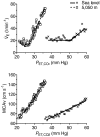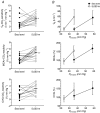Influence of high altitude on cerebrovascular and ventilatory responsiveness to CO2
- PMID: 20026618
- PMCID: PMC2825616
- DOI: 10.1113/jphysiol.2009.184051
Influence of high altitude on cerebrovascular and ventilatory responsiveness to CO2
Abstract
An altered acid-base balance following ascent to high altitude has been well established. Such changes in pH buffering could potentially account for the observed increase in ventilatory CO(2) sensitivity at high altitude. Likewise, if [H(+)] is the main determinant of cerebrovascular tone, then an alteration in pH buffering may also enhance the cerebral blood flow (CBF) responsiveness to CO(2) (termed cerebrovascular CO(2) reactivity). However, the effect altered acid-base balance associated with high altitude ascent on cerebrovascular and ventilatory responsiveness to CO(2) remains unclear. We measured ventilation , middle cerebral artery velocity (MCAv; index of CBF) and arterial blood gases at sea level and following ascent to 5050 m in 17 healthy participants during modified hyperoxic rebreathing. At 5050 m, resting , MCAv and pH were higher (P < 0.01), while bicarbonate concentration and partial pressures of arterial O(2) and CO(2) were lower (P < 0.01) compared to sea level. Ascent to 5050 m also increased the hypercapnic MCAv CO(2) reactivity (2.9 +/- 1.1 vs. 4.8 +/- 1.4% mmHg(1); P < 0.01) and CO(2) sensitivity (3.6 +/- 2.3 vs. 5.1 +/- 1.7 l min(1) mmHg(1); P < 0.01). Likewise, the hypocapnic MCAv CO(2) reactivity was increased at 5050 m (4.2 +/- 1.0 vs. 2.0 +/- 0.6% mmHg(1); P < 0.01). The hypercapnic MCAv CO(2) reactivity correlated with resting pH at high altitude (R(2) = 0.4; P < 0.01) while the central chemoreflex threshold correlated with bicarbonate concentration (R(2) = 0.7; P < 0.01). These findings indicate that (1) ascent to high altitude increases the ventilatory CO(2) sensitivity and elevates the cerebrovascular responsiveness to hypercapnia and hypocapnia, and (2) alterations in cerebrovascular CO(2) reactivity and central chemoreflex may be partly attributed to an acid-base balance associated with high altitude ascent. Collectively, our findings provide new insights into the influence of high altitude on cerebrovascular function and highlight the potential role of alterations in acid-base balance in the regulation in CBF and ventilatory control.
Figures

 ) and middle cerebral artery velocity (MCAv) vs. end-tidal
) and middle cerebral artery velocity (MCAv) vs. end-tidal (
( ) from a representative individual during the modified rebreathing method at sea level and following ascent to 5050 m This graph depicts the typical breath-by-breath
) from a representative individual during the modified rebreathing method at sea level and following ascent to 5050 m This graph depicts the typical breath-by-breath  and MCAv vs.
and MCAv vs.  during modified rebreathing. The horizontal lines during modified rebreathing were used to calculate basal
during modified rebreathing. The horizontal lines during modified rebreathing were used to calculate basal  . The slopes represent linear regression used to calculate the ventilatory CO2 sensitivity and cerebrovascular CO2 reactivity during modified rebreathing.
. The slopes represent linear regression used to calculate the ventilatory CO2 sensitivity and cerebrovascular CO2 reactivity during modified rebreathing.
 , ventilation; MCAv, middle cerebral artery velocity; CVCi, cerebrovascular vascular conductance index. **Different from sea level (P < 0.01).
, ventilation; MCAv, middle cerebral artery velocity; CVCi, cerebrovascular vascular conductance index. **Different from sea level (P < 0.01).

 CO2 sensitivity) at 5050 m. These findings indicate that the increase in MCAv CO2 reactivity and reduction in ventilatory recruitment threshold following ascent to 5050 m are related to an altered acid–balance balance. **Significant correlation (P < 0.01).
CO2 sensitivity) at 5050 m. These findings indicate that the increase in MCAv CO2 reactivity and reduction in ventilatory recruitment threshold following ascent to 5050 m are related to an altered acid–balance balance. **Significant correlation (P < 0.01).Comment in
-
Every breath you take: acclimatisation at altitude.J Physiol. 2010 Jun 1;588(Pt 11):1811-2. doi: 10.1113/jphysiol.2010.188615. J Physiol. 2010. PMID: 20516344 Free PMC article. No abstract available.
-
Ascent to altitude: an integrated cerebrovascular, ventilatory and acid-base response.J Physiol. 2010 Jun 1;588(Pt 11):1815-6. doi: 10.1113/jphysiol.2010.189837. J Physiol. 2010. PMID: 20516346 Free PMC article. No abstract available.
Similar articles
-
Effects of acetazolamide on cerebrovascular function and breathing stability at 5050 m.J Physiol. 2012 Mar 1;590(5):1213-25. doi: 10.1113/jphysiol.2011.219923. Epub 2012 Jan 4. J Physiol. 2012. PMID: 22219343 Free PMC article. Clinical Trial.
-
Influence of sympathoexcitation at high altitude on cerebrovascular function and ventilatory control in humans.J Appl Physiol (1985). 2012 Oct;113(7):1058-67. doi: 10.1152/japplphysiol.00463.2012. Epub 2012 Jul 26. J Appl Physiol (1985). 2012. PMID: 22837165
-
AltitudeOmics: enhanced cerebrovascular reactivity and ventilatory response to CO2 with high-altitude acclimatization and reexposure.J Appl Physiol (1985). 2014 Apr 1;116(7):911-8. doi: 10.1152/japplphysiol.00704.2013. Epub 2013 Dec 19. J Appl Physiol (1985). 2014. PMID: 24356520
-
Integration of cerebrovascular CO2 reactivity and chemoreflex control of breathing: mechanisms of regulation, measurement, and interpretation.Am J Physiol Regul Integr Comp Physiol. 2009 May;296(5):R1473-95. doi: 10.1152/ajpregu.91008.2008. Epub 2009 Feb 11. Am J Physiol Regul Integr Comp Physiol. 2009. PMID: 19211719 Review.
-
Cerebral blood flow, cerebrovascular reactivity and their influence on ventilatory sensitivity.Exp Physiol. 2021 Jul;106(7):1425-1448. doi: 10.1113/EP089446. Epub 2021 May 20. Exp Physiol. 2021. PMID: 33932955 Review.
Cited by
-
Ascent to altitude: an integrated cerebrovascular, ventilatory and acid-base response.J Physiol. 2010 Jun 1;588(Pt 11):1815-6. doi: 10.1113/jphysiol.2010.189837. J Physiol. 2010. PMID: 20516346 Free PMC article. No abstract available.
-
Alterations in cerebral blood flow and cerebrovascular reactivity during 14 days at 5050 m.J Physiol. 2011 Feb 1;589(Pt 3):741-53. doi: 10.1113/jphysiol.2010.192534. Epub 2010 Nov 1. J Physiol. 2011. PMID: 21041534 Free PMC article. Clinical Trial.
-
Cerebrovascular reactivity is increased with acclimatization to 3,454 m altitude.J Cereb Blood Flow Metab. 2015 Aug;35(8):1323-30. doi: 10.1038/jcbfm.2015.51. Epub 2015 Mar 25. J Cereb Blood Flow Metab. 2015. PMID: 25806704 Free PMC article. Clinical Trial.
-
The cerebrovascular response to carbon dioxide in humans.J Physiol. 2011 Jun 15;589(Pt 12):3039-48. doi: 10.1113/jphysiol.2011.206052. Epub 2011 Apr 26. J Physiol. 2011. PMID: 21521758 Free PMC article.
-
Acetazolamide and cerebrovascular function at high altitude.J Physiol. 2012 Jun 15;590(12):2945-6; author reply 2947. doi: 10.1113/jphysiol.2012.233569. J Physiol. 2012. PMID: 22707596 Free PMC article. No abstract available.
References
-
- Aaslid R, Markwalder TM, Nornes H. Noninvasive transcranial Doppler ultrasound recording of flow velocity in basal cerebral arteries. J Neurosurg. 1982;57:769–774. - PubMed
-
- Ainslie PN, Barach A, Murrell C, Hamlin M, Hellemans J, Ogoh S. Alterations in cerebral autoregulation and cerebral blood flow velocity during acute hypoxia: rest and exercise. Am J Physiol Heart Circ Physiol. 2007;292:H976–983. - PubMed
-
- Ainslie PN, Burgess KR. Cardiorespiratory and cerebrovascular responses to hyperoxic and hypoxic rebreathing: effects of acclimatization to high altitude. Respir Physiol Neurobiol. 2008;161:201–209. - PubMed
-
- Ainslie PN, Duffin J. Integration of cerebrovascular CO2 reactivity and chemoreflex control of breathing: mechanisms of regulation, measurement, and interpretation. Am J Physiol Regul Integr Comp Physiol. 2009;296:R1473–1495. - PubMed
-
- Ainslie PN, Ogoh S, Burgess K, Celi L, McGrattan K, Peebles K, Murrell C, Subedi P, Burgess KR. Differential effects of acute hypoxia and high altitude on cerebral blood flow velocity and dynamic cerebral autoregulation: alterations with hyperoxia. J Appl Physiol. 2008;104:490–498. - PubMed
Publication types
MeSH terms
Substances
LinkOut - more resources
Full Text Sources
Other Literature Sources
Miscellaneous

